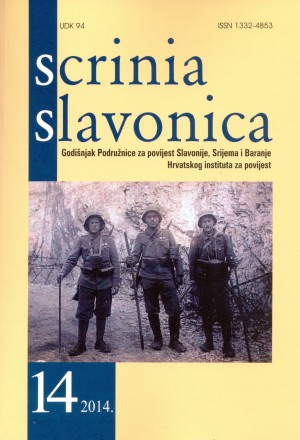Pravoslavna crkva u Šarengradu - primjer barokno-klasicističkoga Gesamtkunstwerka
The orthodox church in Šarengrad – an example of a baroque-neo-classic Gesamtkunstwerk
Author(s): Dragan DamjanovićSubject(s): History, Fine Arts / Performing Arts, Cultural history
Published by: Hrvatski institut za povijest
Keywords: Šarengrad; orthodox church; Baroque classicism; Battle of Kosovo
Summary/Abstract: The Orthodox church in Šarengrad, although today in very poor condition, belongs among the most interesting and in terms of equipment and furnishing the most opulent of religious buildings of the extreme east of Croatia. This spacious Baroque-Neoclassical building, interesting not only for its art-historical but also for its cultural-historical signifi cance, has for a long time been overshadowed by the medieval monuments of Šarengrad, by the older medieval (later baroquized) Franciscan parish church and by the fortress. Newly discovered resources in the archive of the Serbian Orthodox congregation in Šarengrad, kept in the church itself, reveal that the building was erected between 1791 and 1800 according to the design of an unknown master builder as a single-nave and single-tower building. After the church was built, no very large items of new equipment were obtained for more than three decades. All the facilities of the old church were transferred to the new church. The prestigious throne of the Mother of God, constructed in 1783, was preserved as were some icons from the 18th century, which were transferred to the Gallery of Matica Srpska in Novi Sad. In 1818 the painter Peter Čortanović was commissioned to design a new icon of the Mother of God with Christ and in 1825 a new altar was placed in the apse, a good piece of Neoclassic work made of red marble. Three years later, in 1828, after the church fund was replenished, the Šarengrad congregation decided to acquire a new architectural iconostasis frame and other necessary woodwork: choirs, the Archierius’ throne, ripidia, the cross, chairs for church walls as well as other small parts of equipment. These elements were designed between 1830 and 1832 by the well-regarded wood-carver (icon-carver) Georgije Dević from Bačka Palanka. The large Baroque-Neoclassic iconostasis is one of the last perfectly preserved and one of the most magnifi cent iconostases of the first half of the 19th century in Croatia.
Journal: Scrinia Slavonica
- Issue Year: 2014
- Issue No: 14
- Page Range: 107-128
- Page Count: 22
- Language: Croatian

